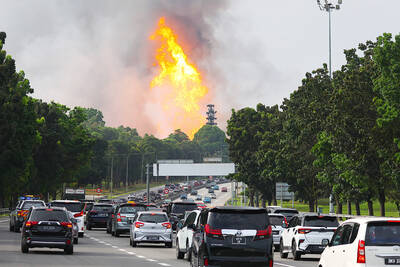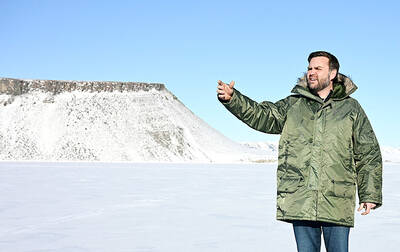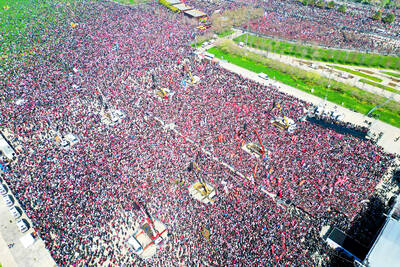In a cramped laboratory, a biologist with the Institute of Cetacean Research prepares plugs taken from whales' ears for age analysis. Scientists study their reproductive habits, food sources and the mercury levels in their tissue.
And then, of course, there's the guy who studies the best way to kill them.
For nearly two decades, as commercial whaling has largely vanished under a global ban, a half-dozen Japanese vessels have sailed off to the waters of Antarctica and the northwestern Pacific each year to hunt, kill and bring home samples of whales for an ongoing research program -- along with tonnes of meat for sale.
Possibly no other Japanese government-backed activity has so isolated Tokyo from its allies in the US and Europe, or so enraged environmental groups.
But at this institute, which serves as the heart of the operation, officials bristle at the suggestion they are doing anything wrong. Instead, they argue that they are fighting the good fight, and that the whaling ban is akin to Hindus forcing the world to stop eating beef, or Muslims banning pork.
Government negotiators are even more strident.
"Why should we back down?" said Shuya Nakatsuka, a Fisheries Agency official in charge of Japan's international whaling agreements. "It is those who oppose whaling who should change."
Tokyo's push for a resumption of commercial whaling will likely put it in the hot seat once again when the International Whaling Commission (IWC) holds its annual convention in Italy next month. Last year's meeting ended with a resolution for Japan to halt its research program. That generated angry calls in Tokyo for the country to retaliate by quitting the group, or at least withhold funding.
"We are still considering our options," Nakatsuka said. "We will have to see how the meeting goes."
The research fleet, meanwhile, is readying its harpoons.
The Nisshin Maru mothership, accompanied by a trawler and sighting-sampling vessels, will set off this Thursday on its annual summer hunt in the northwestern Pacific to kill 100 minke whales, 50 Bryde's whales, 50 sei whales and 10 sperm whales. Another 50 minke whales will be hunted along Japan's shores.
Earlier this year, the fleet returned from the Antarctic, where it killed about 400 minke whales.
The primary goals of the research are to determine how many whales are out there, how long they live, how fast they breed, what they eat and ultimately how many could be killed commercially without significantly depleting their stocks.
Hiroshi Hatanaka, who heads the program, said that whenever possible, data is taken with non-lethal methods, such as simple observation or firing arrows from crossbow-like devices to pull out plugs of skin for DNA sampling.
But he said that isn't enough. The research requires the killing of whales, and not just a few here and there -- hundreds must be taken to get a statistically meaningful sample.
"We study their eating habits by examining the content of their stomachs," Hatanaka said. "Determining their age requires acquiring the tissue in their ears. You can't get this data by merely watching a live whale."
Greenpeace and several other environmental groups claim that is a smoke-screen.
"Though there may be some kinds of research that require killing, the Japanese researchers use this as an excuse to get what they really want, which is the whale meat," said Junko Sakurai, Greenpeace Japan's whaling expert. "It's just commercial whaling in disguise."
Hatanaka acknowledged that about 2,720 tonnes of whale meat were sold last year, bringing in US$52 million. But he said the money was used to fund the program in keeping with IWC rules, which require byproducts of the research not to be wasted.
Opposition notwithstanding, Japan has compiled a formidable case.
In 1992, the IWC's own scientific committee acknowledged that, with about 760,000 minke whales in the Antarctic, an annual take of 2,000 could continue for the next 100 years without hurting overall stocks.
But Dan Goodman, a Canadian who serves as a spokesman for the research institute, complained the scientific side of the argument has been ignored.
"Australia is the best example," he said.
"They kill 6 million kangaroos every year, but they're opposed to the killing of even one whale. It's a political freebie. It's a `your-problem-not-mine.' There's no constituency in Australia for whaling," he said.
Goodman also noted Japan has been singled out more than Norway, which resumed commercial whaling despite the IWC ban.
"Norway is seen as having a good record on the environment," he said.
"The perception of Japan in a broad array of environmental issues is very negative -- `They cut down every tree to make disposable chopsticks, they use way too much energy.' Japan has a public image problem," he said.

A fire caused by a burst gas pipe yesterday spread to several homes and sent a fireball soaring into the sky outside Malaysia’s largest city, injuring more than 100 people. The towering inferno near a gas station in Putra Heights outside Kuala Lumpur was visible for kilometers and lasted for several hours. It happened during a public holiday as Muslims, who are the majority in Malaysia, celebrate the second day of Eid al-Fitr. National oil company Petronas said the fire started at one of its gas pipelines at 8:10am and the affected pipeline was later isolated. Disaster management officials said shutting the

US Vice President J.D. Vance on Friday accused Denmark of not having done enough to protect Greenland, when he visited the strategically placed and resource-rich Danish territory coveted by US President Donald Trump. Vance made his comment during a trip to the Pituffik Space Base in northwestern Greenland, a visit viewed by Copenhagen and Nuuk as a provocation. “Our message to Denmark is very simple: You have not done a good job by the people of Greenland,” Vance told a news conference. “You have under-invested in the people of Greenland, and you have under-invested in the security architecture of this

Japan unveiled a plan on Thursday to evacuate around 120,000 residents and tourists from its southern islets near Taiwan within six days in the event of an “emergency”. The plan was put together as “the security situation surrounding our nation grows severe” and with an “emergency” in mind, the government’s crisis management office said. Exactly what that emergency might be was left unspecified in the plan but it envisages the evacuation of around 120,000 people in five Japanese islets close to Taiwan. China claims Taiwan as part of its territory and has stepped up military pressure in recent years, including

UNREST: The authorities in Turkey arrested 13 Turkish journalists in five days, deported a BBC correspondent and on Thursday arrested a reporter from Sweden Waving flags and chanting slogans, many hundreds of thousands of anti-government demonstrators on Saturday rallied in Istanbul, Turkey, in defence of democracy after the arrest of Istanbul Mayor Ekrem Imamoglu which sparked Turkey’s worst street unrest in more than a decade. Under a cloudless blue sky, vast crowds gathered in Maltepe on the Asian side of Turkey’s biggest city on the eve of the Eid al-Fitr celebration which started yesterday, marking the end of Ramadan. Ozgur Ozel, chairman of the main opposition Republican People’s Party (CHP), which organized the rally, said there were 2.2 million people in the crowd, but